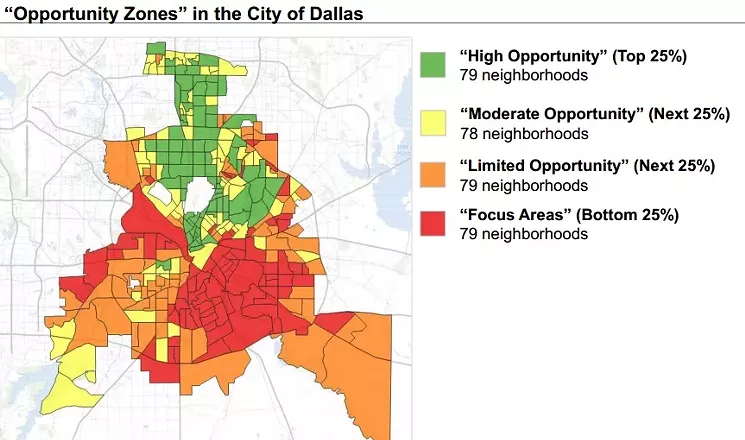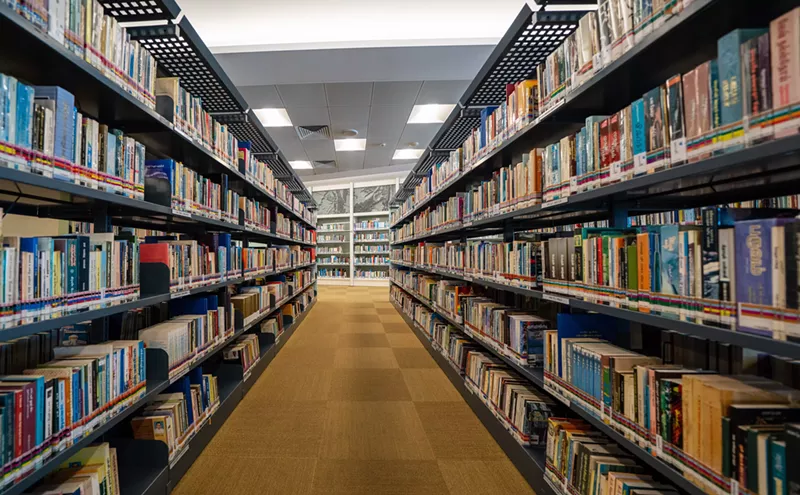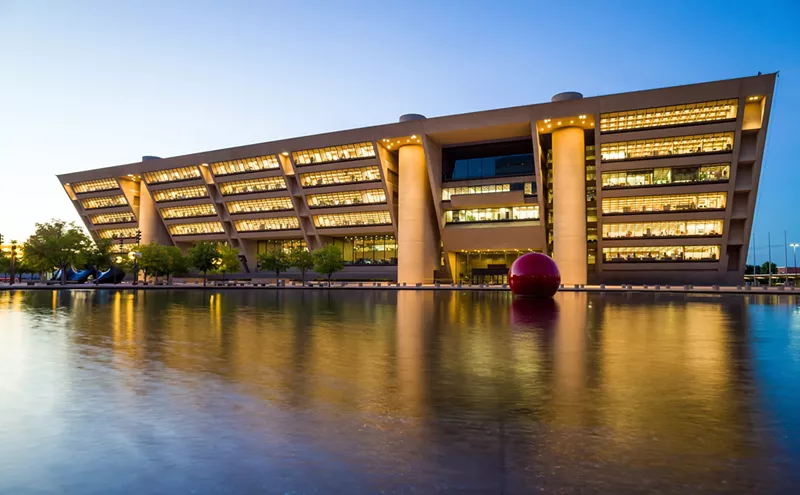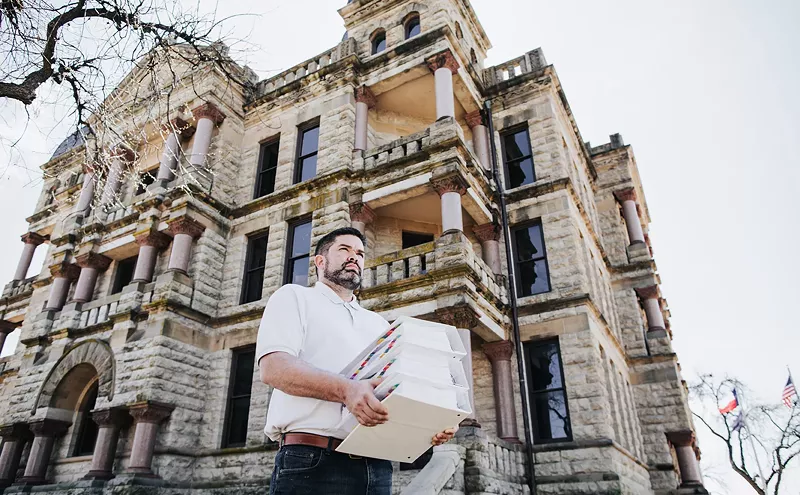But only as an aside, no big deal, just me up here in the bleachers mumbling to myself: I’d like to point out that segregation probably isn’t too good for affluent white kids, either.
A group called Opportunity Dallas made a splash and continues to draw kudos and attention for a report it presented recently to city officials called “Separate and Unequal: How Segregation Shapes Poverty in Dallas.” I wrote about it a couple of weeks ago.
First, the report depicts the extreme segregation of Dallas by race and income. It goes on to make some points most of us can get pretty easily. Poverty in Dallas is a marker for race. Race is a marker for poverty. Draw a map of the city’s poorest areas. Now draw one of the most segregated minority areas. Same map.
If the lottery of birth delivers a new baby to that map, then all of that baby’s windows and opportunities in life will be powerfully shaped by the conditions on the map. That’s not to say some individual baby won’t grow up and change her or his destiny by force of will. But it does say the odds are going to be a lot tougher for most babies on the poverty map than on the ones born to the map of affluence.
Mike Koprowski, executive director of Opportunity Dallas and former chief of transformation and innovation at the Dallas school district, is an effective apostle for putting poor kids into socioeconomically diverse schools. His message is that integration and diversity, especially in housing policy and schools, offer the only practical paths forward toward a solution for the city’s poverty problem.
But what does that mean about white? The whiter the better? No. In fact, hold on there, Mr. White Man. That’s not what it means at all.
Remember that key term, diverse. A persuasive body of research shows that groups get less smart the more exclusively white they are. If anything, the ill effects of segregation may operate almost equally at both sides of the racial dial: less diverse is less good for everybody.
Poverty in Dallas is a marker for race. Race is a marker for poverty. Draw a map of the city’s poorest areas. Now draw one of the most segregated minority areas. Same map.
tweet this
This year in response to some of Trump’s anti-immigrant measures, Scientific American republished an article from 2014 called “How diversity makes us smarter,” summarizing scientific research from around the nation and world. The findings are consistent: The closer to being all white and all male that an organization is, the less smart and less successful it will be.
In one study, Cristian Deszö of the University of Maryland and David Ross of Columbia University looked at gender diversity in companies at the top of the Standard & Poor's Composite 1500 list. Between 1992 and 2006, companies with women in top jobs were worth an average of $42 million more than companies without. Companies whose success depended on innovation made substantially more money when top ranks included gender diversity. A global study of 2,360 firms by Credit Suisse Research Institute in 2012 affirmed those conclusions.
In the early 2000s, a series of scientific studies carried out separately and independently at major universities across the country looked at racial diversity and decision-making in small groups. Those results also were consistent. They showed that people in racially diverse groups take opposing opinions more seriously and work harder to persuade people with differing opinions to their own views. For example, people do more homework and try harder to prepare good arguments in advance of a meeting when they know the group will be racially diverse.
The evidence is that diversity is challenging and not always fun but that people think better and get smarter in diverse groups. That even goes for scientists.
In 2014, Harvard economics professor Richard Freeman, director of the Science and Engineering Workforce Project at the National Bureau of Economic Research, examined the ethnic identities of the authors of 1.5 million scientific papers written between 1985 and 2008. His team found that scientific papers written by racially and ethnically diverse groups of scientists were cited more often by other scientists and had more impact on their fields than papers produce by mono-ethnic groups of scientists.
It seems to me there are other characteristics of the concentrated whiteness phenomenon that are too obvious and too pressing right now to ignore in a chat like this. Last week in an op-ed column in The New York Times, Thomas B. Edsall presented research by Will Stancil at the Institute on Metropolitan Opportunity at the University of Minnesota Law School showing that the 2016 Trump vote was strongest in the most segregated white communities.
In diverse but Republican-voting suburbs, on the other hand, the 2016 Trump vote stayed about even with the 2012 Romney vote. But in places where white percentages were in the high 80s or 90s and always had been, Trump’s vote soared much higher in 2016 than Romney’s vote had been four years earlier.
Edsall had a complicated explanation for that, arguing, I think, that the diversity wars were sort of over and done with in the closer-in diverse suburbs, so … what? I don’t know. White people there have given up? He suggested that white people in the all-white regions of the country feel more threatened and think they have more to lose because their communities aren’t diverse yet.

The maps of poverty, segregation an opportunity in Dallas are all basically the same map.
Opportunity Dallas
But let’s travel east 100 miles to Wood County, which the census says was 91.5 percent white in 2016. The vote there was pro-Trump by 86 percent to 14 percent for Clinton.
Look, I know three counties do not a nation make, but in looking at the national research, Edsall showed that areas with very high percentages of whites are dramatically more responsive to Trump’s message. I’m not disagreeing with him about whites there feeling more threatened. But why?
Have you ever been to Wood County? I love Wood County. Take out a topo map: It’s the closest place to Dallas you can find with anything a transplanted Yankee would consider to be real terrain. And I love the people of Wood County. They are a hardworking, dignified lot. Very white.
Wood County is more realistically threatened by falling weather satellites than by diversity. In a good many years in Dallas, I have never heard a black or Hispanic friend or colleague say, “Oh, I just can’t wait to move my family to Wood County.” In fact, I had a black reporter friend tell me once he had a big red marker-pen circle drawn around Wood County in his mental map of Texas as a place to avoid at all costs.
I just think people are more afraid in all-white settings. They suffer worse from the racial heebie-jeebies because they’ve never known anybody black or Hispanic. They’ve never gone to church or bowling or out drinking with anybody who didn’t look at least like a possible second cousin.I just think people are more afraid in all-white settings. They suffer worse from the racial heebie-jeebies because they’ve never known anybody black or Hispanic.
tweet this
The whiter, the more fearful. And I hate to say it — sorry, don’t mean to be hurtful — but social smarts come from social experience, so the whiter, the less smart, socially, anyway.
I don’t think the white people in diverse communities have given up on anything. I think they’re leading a better life, a more confidant life, a life in which they feel more competent to deal with people who don’t look like them. Nothing makes people more afraid or frozen than lack of experience. We all know that. That’s why you can get them all riled up by shaking scarecrows in their faces.
I offer this to make one point only. There is a flip side to what Koprowski at Opportunity Dallas is saying (and I bet he knows it better than I do). Yes, segregation is bad and diversity is good for poor minority kids. But segregation is bad and diversity is good for white kids, too.
Take a good long look at this world we’re sending them out into. There’s no more white Christmas, man. White Christmas is history. It’s Christmas, Hanukkah, Ramadan, Diwali, et cetera, in the colors of the rainbow.
That doesn’t mean your white Christian kid has to give up Christmas. But it does mean he’ll be better off in life if knows about the other stuff, as well. That’s how diversity blesses white children as much as it does minority kids. Worth keeping in mind?












